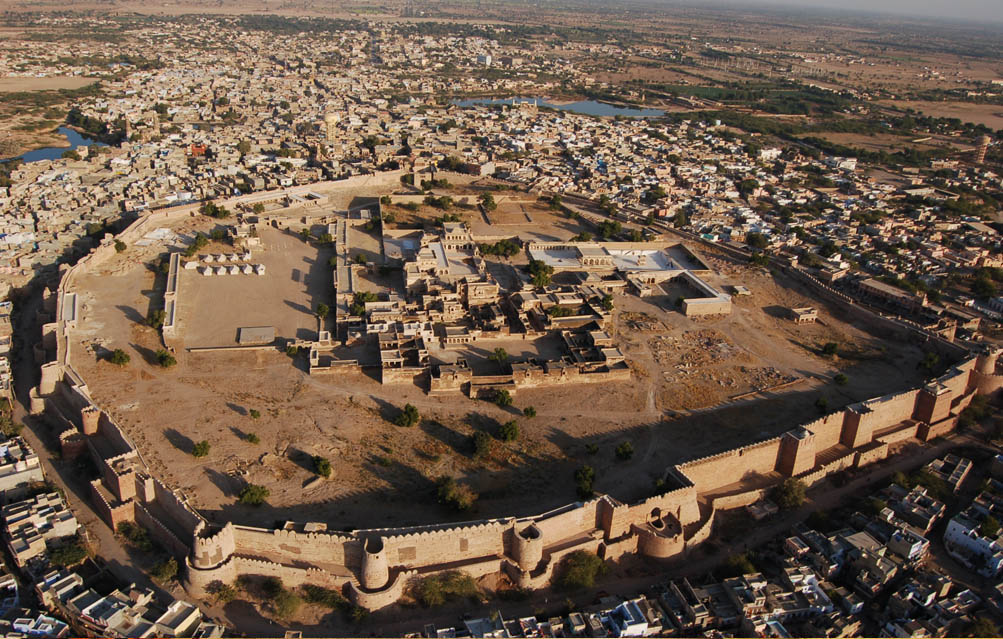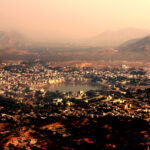This wasn’t a well-planned tour; last minute tickets, itinerary gone through in haste, no pre-research done and entire plan charted out on way to the railway station. My first impression of Nagaur, as I landed the next morning, was that of a quaint town. I took a corner in that humble station and rolled my eyes to detail out every corner, to assure me that I was still in this century. ‘The town looks ancient’ I said to myself, coming out of the station. This was Nagaur, in the arid northwest of India’s largest state, Rajasthan. Bordering the Thar desert, most of the cityscape has been painted royal yellow with a magnificent Fort standing in the middle of the city; the city walls echoing the tales from time immemorial and the fort speaking of tales of glory and valour.

Landscape view of the Nagaur Fort
I was soon drawn into a history lesson by my chauffeur as we drove to the hotel. A major draw for anyone seeking an immersion in courtly history, Nagaur grew from a strategic trade point to the centre of Rajputana power in its hey days. Naguar lived under the influence of conquerors from vastly different cultures. Over time it gained a distinct Rajput-Mughal architectural design as gardens, temples and fountains were added. Passing through the town is like passing through an age frozen and wrapped in time. The city seems as unmoved by changing times. The 4th century Ahichhatragarh Fort, standing in the middle of the city, was originally built by the Nagavanshi clan (hence the name that means ‘Fort of the Hooded Cobra’!) and rebuilt in the 12th century by the Ghaznis to include palaces and mosques. The Nagaur Fort epitomizes the city more than anything else.

The city seems unmoved by changing times: Ahichhatragarh Fort
I was at the major draw of the city, the Ahichhatragarh Fort; built in the middle of a flat land, with a not so deep moat and not very high walls, the Nagaur Fort doesn’t fit very well in the Indian definition of forts. It is virtually at ground level, commanding no sweeping views of the countryside; quite a maverick architecture, I would say. Nagaur was Rajput ruler Amar Singh’s fiefdom, quite a maverick himself. Having earned his father’s Gaj Singh’s, ruler of Marwar, ire, he was sent on exile, all credit to his impetuous nature; Amar Singh joined hands with the Mughals, and won back Nagaur, which later grew under his influence and undiminishing taste for art.
Over time, the fort moved from the Rathores to the Mughals to the British and then back to the Rathores and then the Government to house sundry offices and then as a base for the Border Security Force (BSF). In 2002, it won the UNESCO Asia Pacific Award of Excellence for Cultural Heritage Conservation tag and came under the Mehrangarh Museum Trust, run by the Rathore royals, helping this maverick fort restore its glory. Soon, the fort was brought alive, decays swept away from the walls of the palaces and turned it into a tourist destination, albeit less known that other fort cities in Rajasthan.

Nagaur Fort doesn’t fit very well in the Indian definition of forts. It’s a maverick structure.

Over time, the fort has moved from the Rathores to the Mughals to the British and then back to the Rathores.
A walk through the alleys of the fort reveals that it meant more for pleasure than planning warfare. The Sheesh Mahal, the Akbari Mahal via with the Zenani Deori or women’s apartments and the Hawa Mahal are epitomes of structural beauty. Inspite of their mutilated condition, the murals on the walls display the qualities of good craftsmanship, sensitive imagination and well organized composition. It’s not difficult to decipher the inclinations of the artists who made these murals – the court and hunting scenes that are painted on some walls are an oddity, the constant themes are of dances, folk tales and even fairies. In the ‘Falgun Mahal’, the ceiling is embellished with long sleepers of red sand stone, veneered with a coating of lime and marble dust. Over this surface the figures are painted in the ‘fresco buono’ style known as Jaipur process.
Deepak Mahal with its Persian-style floral designs and several niches in the inner walls to hold lamps, the Abha Mahal with its eloquently designed water features in the form of channels, fountains and hamams and the Akbari Mahal, built to commemorate the recapture of Nagaur by the Mughals in the mid-16th century, speak of the heights of the heights of Rajput-Mughal style of architecture of Nagaur Fort.
I took to the top floors to catch a bird’s eye view of the entire complex – it looked splendid – the numerous pools to keep the fort cool in dry summers, the temples in the corners, a mosque built by Shah Jahan with its blue tiled mosaic work – all drawn in a simple geometric lining. the structures command a hyponetic appeal and easily transitions the onlooker back to the Rajputana era, within minutes. No denying, here is still so much of history to come close to and protect here.
Nagaur Cattle Fair
Every year in first week of February, this small town doubles up as host to India’s second largest cattle fair. With lavishly decorated cattle, music performances, crazy races, handicraft shops, puppetry shows, jugglery acts, towering piles of spicy red chillies in the unmissable Mirchi bazaar, the spirit of festivity soars in the city during this fest.


Luxury tents in Nagaur




Very informative post with some great shots of the fort!
Thanks Saif, this blog is very different from how I usually write. Happy that you liked it..
[…] via Rajputana revisited at Nagaur — Hand of Colors […]
splendid pictures n informative post also n amazing in reading thanks for sharing
Thanks Shrey – these words mean a lot